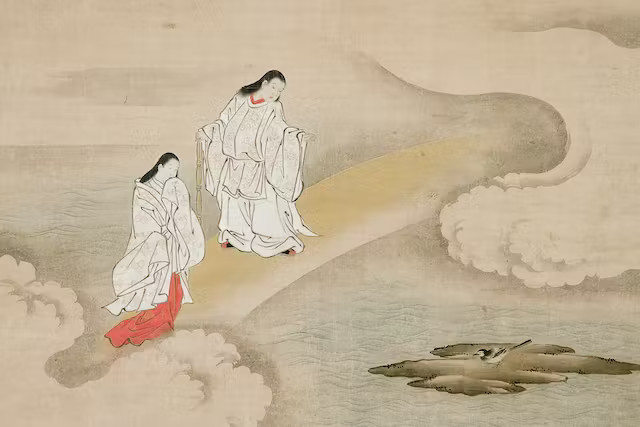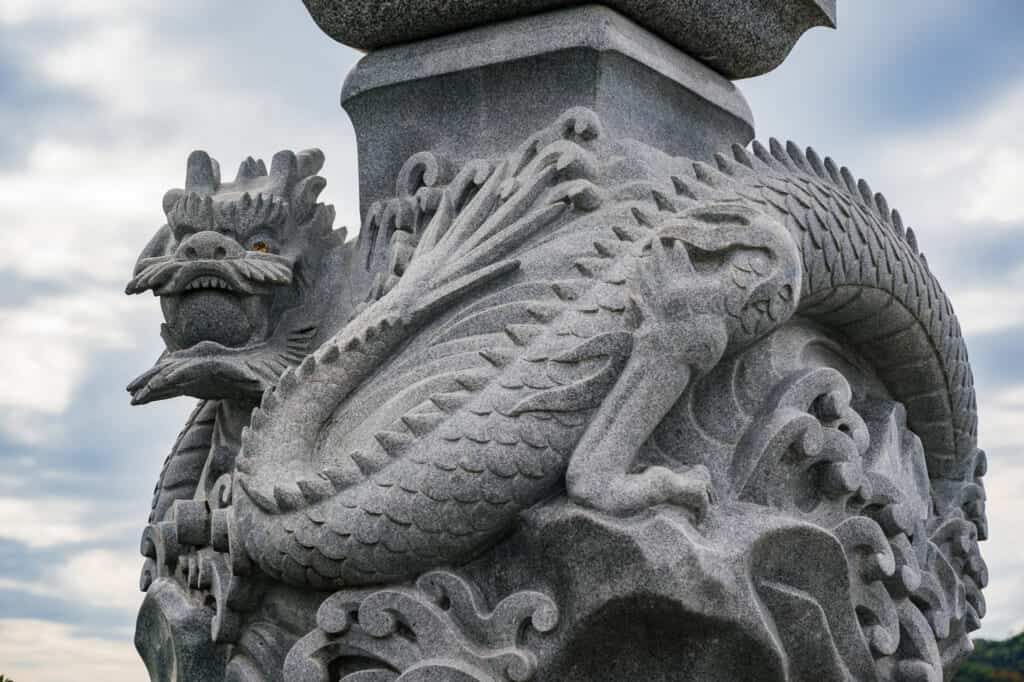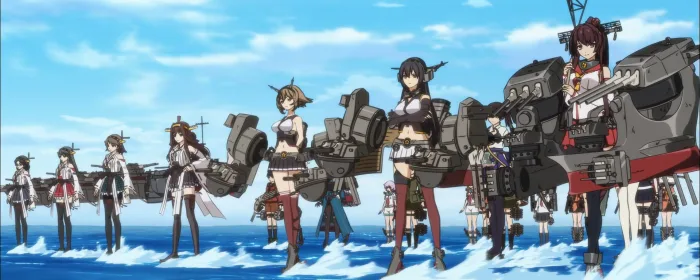Archipelago of Gods: Mythological Origins of Japanese Islands
Introduction: Japan - A Mosaic of Mythical Islands

Japanese culture is replete with references to its archipelago - from ancient temples and festivals to modern-day anime and manga. The islands are not merely backdrops to these tales, but often play a central role, acting as a bridge between the physical world and Japan's spiritual heritage. Many of these stories have deeply embedded themselves in the hearts of the Japanese, shaping their perception of themselves and the world around them. In this article, I invite you to discover how mythical tales about the islands have influenced what Japan is today.
 The Beginning: Onogoro Island
The Beginning: Onogoro Island
At the heart of Japanese mythology lies the story of world creation, and playing a pivotal role in this tale is the island of Onogoro. Imagine a space like a dark watery abyss, stirred only by primordial deities. From this infinity, Izanagi and Izanami, a pair of deities, received a heavenly spear, "ame-no-nuboko", which they dipped into the primeval sea. As they lifted the spear, droplets of water fell from it, crystallizing into the form of Onogoro Island.
Izanami and Izanagi chose to settle on this new land. Soon after, they married and became the creators of many deities and other elements of the world. Onogoro became the scene of their initial experiences, both beautiful and tragic.

For example, in anime and manga, the theme of world creation and the relationship between gods is often explored. "Noragami", a popular manga and anime series, depicts a world where deities live alongside humans, in a narrative reminiscent of the interactions of Izanami and Izanagi. Similarly, "Kamisama Kiss" tells the story of a girl who becomes a deity and her interactions with other gods, harking back to ancient myths.
While Onogoro might not be directly mentioned in each of these works, its spirit and symbolism are present in many aspects of Japanese pop culture. The influence of this mythical island on Japan's culture is enduring and undeniable.
The Eight Descendant Islands:
Awaji: The first of the eight descendant islands, which according to the "Kojiki" emerged from the union of Izanami and Izanagi. Positioned between Honshu and Shikoku, Awaji is often seen as a bridge connecting these two large islands. Its mythological significance lies in its role as the "firstborn", forming the foundation for the subsequent islands created by the deities.
 Iyo (Shikoku): Shikoku, also known as Iyo, is the smallest of the four main islands of Japan. It is home to 88 Buddhist temples, which are the target of an important pilgrimage in Japan. This pilgrimage has roots in ancient faith and culture, referencing the island's mythological tales and legends.
Iyo (Shikoku): Shikoku, also known as Iyo, is the smallest of the four main islands of Japan. It is home to 88 Buddhist temples, which are the target of an important pilgrimage in Japan. This pilgrimage has roots in ancient faith and culture, referencing the island's mythological tales and legends.
Oki: In mythology, the Oki islands are often overlooked or deemed insignificant, but they have their own character. While not the focal point of many myths, their isolated position and unique culture make them a valuable piece of the mosaic of Japanese heritage.
Tsukushi (Kyushu): Kyushu, also known as Tsukushi, is associated with volcanoes, hot springs, and powerful deities. One of the most well-known volcanoes, Aso, has its place in mythology as the home of certain deities. Kyushu's hot springs, known as onsens, are often praised in literature and art as magical and healing places.
Iki: Although small, Iki Island has a rich history in a mythological context. It is believed to have been an important cultural and spiritual site in ancient Japan, with numerous temples and shrines dedicated to various deities.
Tsushima: Located between Korea and Japan, Tsushima is an "island at the frontier of cultures." In mythology, it plays the role of a guardian, a gateway between the two lands. Its location made it an important place for diplomacy and trade in ancient times.
 Sado: While today it is mainly known for taiko music and the Kodo ensemble, Sado has deep roots in Japanese mythology. In ancient times, it was a place of exile for those inconvenient to the authorities, but also a place where culture and art flourished in isolation.
Sado: While today it is mainly known for taiko music and the Kodo ensemble, Sado has deep roots in Japanese mythology. In ancient times, it was a place of exile for those inconvenient to the authorities, but also a place where culture and art flourished in isolation.
Yamato (Honshu): Honshu, also known as Yamato, is the heart of Japan - both geographically and culturally. Many of the country's most famous myths and legends take place on this island. From the birth of the sun god Amaterasu to heroic tales of emperors and warriors - it all happens on Honshu.
It is impossible not to notice that the above list does not include one of the main contemporary islands of Japan – Hokkaido.
 Hokkaido: Beyond the Eight Islands
Hokkaido: Beyond the Eight Islands
In traditional Japanese myths, Hokkaido is often overlooked. This is because, at the time these stories were being formed, Hokkaido was not fully settled by the Japanese. The island, also known as Ezo, was rather a frontier, separating known Japanese culture from the mysterious territories to the north, inhabited by the Ainu people.
The Ainu, the indigenous inhabitants of Hokkaido, have their own rich culture and history, which differs from the Japanese traditions of the main island. Their mythology is based on unique beliefs and legends that describe the creation of their world, nature, and animals. Although Hokkaido is not present in the main Japanese myths, it has its own rich mythological traditions, which are equally fascinating.
Over time, with expansion and colonization, Hokkaido was incorporated into the mainstream of Japanese culture and history. However, despite integration with the rest of the country, it has retained much of its unique identity. Modern Hokkaido is seen as a place where traditions meet modernity, and the Ainu heritage is celebrated.
The Role of Islands in Japanese Culture: Mythology in Anime
Myths about the islands of Japan, their origin, and the gods who shaped them have long fascinated artists. In the world of anime, where the boundaries of reality are often blurred, these legends find new life, combining traditional stories with modern interpretations.
 "Umisho" anime is set on a fictional island whose culture and daily life strongly resemble traditional stories about the first islands of Japan. The main characters participate in ancient rituals and feasts related to the sea, and the whole story is filled with references to mythology and islander culture.
"Umisho" anime is set on a fictional island whose culture and daily life strongly resemble traditional stories about the first islands of Japan. The main characters participate in ancient rituals and feasts related to the sea, and the whole story is filled with references to mythology and islander culture.
In "Kamisama Hajimemashita," the main character becomes a goddess of an earthly sacred place associated with the island of Iyo (Shikoku). Her interactions with other deities and spirits reflect the deep spirituality and mythological roots of this particular island, especially in relation to the main pilgrimage route of temples on Shikoku.
 "Kantai Collection" depicts warships as girls who fight a powerful enemy from the sea. Among these characters are many references to island mythology, such as Tsushima or Sado. The characteristics of the characters reflect the historical and mythological connotations of each island, adding depth to the entire story.
"Kantai Collection" depicts warships as girls who fight a powerful enemy from the sea. Among these characters are many references to island mythology, such as Tsushima or Sado. The characteristics of the characters reflect the historical and mythological connotations of each island, adding depth to the entire story.
The famous anime "Clannad" has elements reminiscent of stories related to Awaji Island. Legend has it that it was on this island that the first dance rituals took place, which later became the basis for traditional Noh theater. In "Clannad", characters often perform traditional dances and songs that reflect this mythological tradition.
In conclusion, anime often utilizes traditional myths and legends about the islands of Japan, introducing them into modern contexts. As a result, viewers not only enjoy thrilling stories but also have the opportunity to immerse themselves in the rich mythology and culture of the archipelago.
Enoshima Island – Another Island Creation Myth Example
Enoshima Island, situated in the Sagami Bay in Kanagawa Prefecture, has been drawing attention for centuries with its beauty and mystique. However, it wasn't always such a tranquil place.

One day, from the depths of the sea, the goddess Benten (also known as Benzaiten) emerged. She decided to settle on a small islet, which later became Enoshima.
When Goddess Benten learned of the menacing dragon, she chose to confront him face to face. Using her divine powers, she persuaded the dragon to reconsider his previous actions.
During the conversation with Benten, Gozuryu fell in love with the goddess. His love was so profound and genuine that he chose to abandon his malevolent ways and live in peace. In exchange for a promise not to harm the villages, Benten allowed him to reside beneath Enoshima, where he was to remain forever.
Thanks to this, Enoshima Island became a place of worship for the goddess Benten and a sanctuary for the dragon Gozuryu. To this day, one can visit the temples dedicated to the goddess and caves where, according to legend, the dragon once lived. These legends attract many tourists and pilgrims who wish to experience the magic of this place and honor the memory of the island's unique history.
Echoes of Island Myths in Contemporary Japan
Modern Japan, while deeply rooted in tradition, continually evolves, drawing inspiration from both its own history and external influences. However, one thing remains constant: Japan is a country of islands, and the mythology of these islands forms the foundation of its cultural identity.
Not only grand epics like the "Kojiki" but also numerous local legends and tales convey the essence of the Japanese spirit. For instance, some believe that the enchanted stones from Oki Island, called "Magatama," worn as amulets, have the power to attract prosperity and happiness. These stones, shaped like delicate droplets of water, symbolize the tears of the goddess Kumoyo.
Contemporary anime and manga often take inspiration from these ancient tales, transforming them into modern narratives that still reflect Japan's deep values and beliefs. In this way, even as centuries pass, the echo of these mythological islands still resonates at the heart of Japanese culture, reminding of the rich heritage that shapes the Land of the Rising Sun.
"Strong Japanese Women"
see book by the author
of the page
未開 ソビエライ
An enthusiast of Asian culture with a deep appreciation for the diverse philosophies of the world. By education, a psychologist and philologist specializing in Korean studies. At heart, a programmer (primarily for Android) and a passionate technology enthusiast, as well as a practitioner of Zen and mono no aware. In moments of tranquility, adheres to a disciplined lifestyle, firmly believing that perseverance, continuous personal growth, and dedication to one's passions are the wisest paths in life. Author of the book "Strong Women of Japan" (>>see more)
Personal motto:
"The most powerful force in the universe is compound interest." - Albert Einstein (probably)
Mike Soray
(aka Michał Sobieraj)
未開 ソビエライ
An enthusiast of Asian culture with a deep appreciation for the diverse philosophies of the world. By education, a psychologist and philologist specializing in Korean studies. At heart, a programmer (primarily for Android) and a passionate technology enthusiast, as well as a practitioner of Zen and mono no aware. In moments of tranquility, adheres to a disciplined lifestyle, firmly believing that perseverance, continuous personal growth, and dedication to one's passions are the wisest paths in life. Author of the book "Strong Women of Japan" (>>see more)
Personal motto:
"The most powerful force in the universe is compound interest." - Albert Einstein (probably)
Mike Soray
(aka Michał Sobieraj)
Write us...
Ciechanów, Polska
dr.imyon@gmail.com
___________________
inari.smart
Would you like to share your thoughts or feedback about our website or app? Leave us a message, and we’ll get back to you quickly. We value your perspective!
 The Beginning: Onogoro Island
The Beginning: Onogoro Island  Iyo (Shikoku): Shikoku, also known as Iyo, is the smallest of the four main islands of Japan. It is home to 88 Buddhist temples, which are the target of an important pilgrimage in Japan. This pilgrimage has roots in ancient faith and culture, referencing the island's mythological tales and legends.
Iyo (Shikoku): Shikoku, also known as Iyo, is the smallest of the four main islands of Japan. It is home to 88 Buddhist temples, which are the target of an important pilgrimage in Japan. This pilgrimage has roots in ancient faith and culture, referencing the island's mythological tales and legends.  Sado: While today it is mainly known for taiko music and the Kodo ensemble, Sado has deep roots in Japanese mythology. In ancient times, it was a place of exile for those inconvenient to the authorities, but also a place where culture and art flourished in isolation.
Sado: While today it is mainly known for taiko music and the Kodo ensemble, Sado has deep roots in Japanese mythology. In ancient times, it was a place of exile for those inconvenient to the authorities, but also a place where culture and art flourished in isolation. Hokkaido: Beyond the Eight Islands
Hokkaido: Beyond the Eight Islands  "Umisho" anime is set on a fictional island whose culture and daily life strongly resemble traditional stories about the first islands of Japan. The main characters participate in ancient rituals and feasts related to the sea, and the whole story is filled with references to mythology and islander culture.
"Umisho" anime is set on a fictional island whose culture and daily life strongly resemble traditional stories about the first islands of Japan. The main characters participate in ancient rituals and feasts related to the sea, and the whole story is filled with references to mythology and islander culture. "Kantai Collection" depicts warships as girls who fight a powerful enemy from the sea. Among these characters are many references to island mythology, such as Tsushima or Sado. The characteristics of the characters reflect the historical and mythological connotations of each island, adding depth to the entire story.
"Kantai Collection" depicts warships as girls who fight a powerful enemy from the sea. Among these characters are many references to island mythology, such as Tsushima or Sado. The characteristics of the characters reflect the historical and mythological connotations of each island, adding depth to the entire story.

